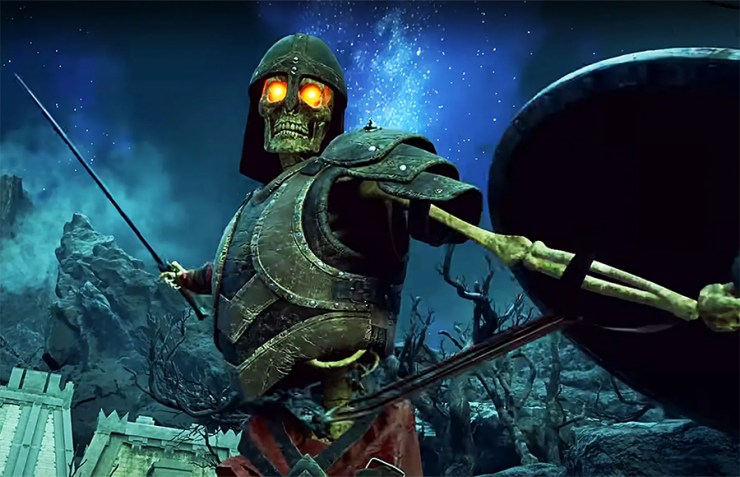Spoiler Warning: This review digs into major plot points.
Most horror fans are familiar with the story of Ed Gein, whether they realize it or not. Also known as the Butcher of Plainfield, the Wisconsin farmer inspired some of the genre’s most disturbing monsters. Norman Bates (Anthony Perkins, Psycho), Buffalo Bill (Ted Levine, The Silence of the Lambs), and Leatherface (Gunnar Hansen, The Texas Chain Saw Massacre) all trace their roots back to this reclusive criminal despite significant differences in each of their stories. The real Ed Gein was famously shy and known around town as a little strange. That all changed on November 21st, 1957, when his rural farmhouse was searched in connection with the disappearance of local businesswoman Bernice Worden. Authorities found a derelict home littered with human remains and decorated with furnishings made from dead bodies. Gein was ultimately convicted of Worden’s murder along with nine counts of grave robbery, and spent the rest of his life in a mental institution.
Infuriatingly vague about his motivations, Gein’s shocking transgressions spoke for themselves, opening the door for amateur sleuths and an army of armchair therapists seeking to understand the “Plainfield Ghoul.” Robert Bloch’s novel Psycho was published just seventeen months later, the first in a long line of genre creators to incorporate elements of Gein’s sordid story while leaving the man’s true nature on the cutting room floor. The latest season of Ryan Murphy’s Monster attempts to reclaim Gein’s legacy alongside the films based on his life. Directed by Max Winkler and Ian Brennan (who also penned the sprawling script), Monster: The Ed Gein Story weaves together the creation of these legendary films in addition to messy explorations of their ongoing appeal. Grisly reproductions of the horrors discovered in his dingy home create an overwhelming atmosphere of depravity, but Brennan and Winkler play fast and loose with established fact and conflate objective truth with fantasy. While making a solid case for Gein’s place as a godfather of horror and true crime, the eight-episode season presents a confusing depiction of the man himself.

Monster: The Ed Gein Story. Laurie Metcalf as Augusta Gein in episode 304 of Monster: The Ed Gein Story. Cr. Courtesy Of Netflix © 2025
We open on Ed (Charlie Hunnam) gently milking a cow and meticulously performing the duties of a farmhand. Moments later, he peeks into his neighbor’s bedroom, then engages in erotic asphyxiation while masturbating in women’s lingerie. Interrupted by his cruel mother Augusta (Laurie Metcalf), Ed soon stands naked in the family living room while she berates him with scripture and scorn. This sequence proves to be a microcosm of Monster’s Ed: a well-meaning son abused by his mother, who equates sexual arousal with violence and destruction. Drawn from reports of Gein’s abusive childhood, we watch as Augusta’s voice overshadows all future interactions and ultimately drives him to kill and dismember women who resemble her.
Murphy made waves by casting the famously attractive Hunnam as the unremarkable Wisconsin farmer, but Brennan and Winkler have taken pains to modify his appearance. A prosthetic growth over one eye, retro haircut, and protruding ears combine with a high-pitched vocal affectation and thick Wisconsin accent to distance the actor from his tough-guy appeal. Hunnam deftly navigates this complicated role, successfully embodying both the sensitive man struggling with an undiagnosed mental illness and the ruthless killer dehumanizing his female victims while worshiping their body parts. At times, he steps in for Gein’s cinematic counterparts, reenacting Psycho’s infamous shower scene and chasing victims with a roaring chainsaw as in The Texas Chain Saw Massacre. But it’s his mirroring of Buffalo Bill that proves most problematic.
From the season’s earliest moments, we watch Ed fetishize women’s lingerie. Scenes in which the handsome actor seductively dances in bra and panties lead to a more sinister version of this benign kink as he dons a busty torso made from human skin and a human mask topped with long, flowing hair. Wearing the upper half of this woman suit, Ed then tucks and dances in the mirror, delighting in his gruesome appearance. Brennan and Winkler juxtapose this disturbing image with a reenactment of an infamous scene from The Silence of the Lambs in which Buffalo Bill gives a similar performance after working on his own skin suit. While clearly meant to connect the dots between Gein’s true crime story and the film’s inspiration, this combination continues a damaging legacy of conflating trans people with violent criminals. There is no evidence to suggest that Gein fetishized women’s undergarments, and his “deviance” was likely a symptom of untreated schizophrenia. We will later hear a doctor explain the nuances of Ed’s mental illness, adding a second diagnosis of gynephilia, but only after several episodes of this troubling imagery.

Monster: The Ed Gein Story. Tom Hollander as Alfred Hitchcock in episode 302 of Monster: The Ed Gein Story. Cr. Courtesy Of Netflix © 2025
Winkler and Brennan are more successful in exploring the aftermath of Alfred Hitchcock’s Psycho. As Ed begins digging up bodies, we travel forward a few years to a Hollywood table in which Bloch (Ethan Sandler) dazzles a rapt Hitchcock (Tom Hollander) with psychobabble meant to explain Gein’s murky motives. We then cut to a young Anthony Perkins (Joey Pollari) preparing for the role he hopes will make him a household name. But a troubling visit to the set leads to second thoughts as he’s confronted with jarring recreations of Gein’s crimes. Alluding to Perkins’ relationship with actor Tab Hunter (Jackie Kay), Hitchcock tells the vulnerable young actor that he was cast specifically because his closeted queerness helps him understand both the “monstrous” Gein and his cinematic counterpart, who murders while wearing his mother’s dress. This upsetting moment forces us to contend with the film’s effect on the queer community and the cost of becoming forever known as the infamous Norman Bates.
As Ed begins wearing the faces of his victims, we meet an idealistic Tobe Hooper (Will Brill) and watch as an obsession with ‘the woman skinner of Wisconsin’ grows into one of the most celebrated horror films of all time. In 70’s parlance, the crass yet insightful director explains that he is making “the movie this country deserves,” while explaining Leatherface’s iconic trio of human skin masks. Horror fans will love this painstakingly accurate peek behind the scenes of the genre-defining classic, along with a gleeful dramatization of Hooper’s inspirational fantasy of using a display chainsaw to cut through an endless line of holiday shoppers.
Missing from the conversation, however, is Demme’s The Silence of the Lambs. Aside from the aforementioned dance, we get very little of this equally influential film. Unlike Psycho and The Texas Chain Saw Massacre, we do not meet the director or novelist Thomas Harris, who wrote the award-winning film’s source material. There is no attempt to unpack the characterization of Buffalo Bill and the lasting harm to the trans community. The only explanation of Gein’s own sexual identity lies in Ed’s imagined conversation with his hero Christine Jorgensen (Alanna Darby), one of the first Americans to successfully undergo gender confirmation surgery.

Monster: The Ed Gein Story. (L to R) Suzanna Son as Adelina, Charlie Hunnam as Ed Gein in episode 302 of Monster: The Ed Gein Story. Cr. Courtesy Of Netflix © 2025
Also frustrating are the season’s glaring inaccuracies. We have no way to prove whether Gein engaged in sexual necrophilia and cannibalism—Gein himself has denied these accusations—but Brennan and Winkler present both as fact with extended scenes in which Ed defiles a corpse and brings human meat to a neighborly dinner. Cinematic depictions of his two confirmed victims are jarringly different from their provable personas, and Ed’s relationship with girlfriend Adeline Watkins (Suzanna Son) has been wildly expanded. While these narrative choices could be excused as a version of women seen through Ed’s tainted eyes, we don’t see a contrast to reality, and must take these outlandish versions as fact. And that’s not to mention multiple sequences following Nazi war criminal Ilse Koch (Vicky Krieps), whose rumored practice of creating lampshades out of human skin reportedly inspired Ed’s own grisly hobbies.
Despite these indulgent fantasies—or perhaps because of them—Monster: The Ed Gein Story is genuinely terrifying. We watch as Ed stalks, kidnaps, and murders a series of women, drawing a direct line to his influence on the slasher subgenre. A ghastly facsimile of the notorious farmhouse shows a bowl constructed from a woman’s skull, a shade adorned with human lips, and a belt made from a series of severed nipples. The camera lingers on a meticulously detailed recreation of the decapitated and dressed out corpse found hanging in Gein’s barn, as well as his horrific woman suit. But perhaps most effective is the corpse meant to represent the undead Augusta. Heightening the shock of Psycho’s famous reveal, this corpse continues to rot as Ed totes her around the house, creating two-sided conversations. Less salacious period details create an icy world of 50s glamor interwoven with the harshness of a rural town.

Monster: The Ed Gein Story. Charlie Hunnam as Ed Gein in episode 304 of Monster: The Ed Gein Story. Cr. Courtesy Of Netflix © 2025
Previous seasons of Monster have sought to humanize notorious murderers while highlighting their often forgotten victims and exploring the impact of their disturbing crimes. Season 3 feels mainly concerned with presenting Ed as a sympathetic if admittedly dangerous man who sparked a sea change in American pop culture. With loving attention to visual detail and graphic depictions of Ed’s documented acts, Brennan and Winkler pull us into his macabre Wisconsin farmhouse and ask us why we can’t seem to look away. Are we complicit in monsterizing a lonely and misunderstood man who simply longed for a mother’s love? Or are we justified in continuing a cultural fascination that birthed modern horror and true crime? Monster: The Ed Gein Story feels like a love letter to fans of these popular genres and an argument that they are intrinsically connected through the story of this strange man. Though the case may be sound and admittedly entertaining, the facts get lost along the way.
Monster: The Ed Gein Story is now streaming on Netflix.


The post ‘Monster: The Ed Gein Story’ Is a Messy Marriage of Horror and True Crime [Review] appeared first on Bloody Disgusting!.

![Uncover Disturbing Obsession Later This Year in Narrative Horror Game ‘VILE: Exhumed’ [Trailer]](https://www.otako.art/wp-content/uploads/2025/03/horror.png)
